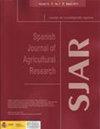Novel draught resistance sensing elements for measurement of drawbar power of agricultural machinery
IF 0.8
4区 农林科学
Q3 AGRICULTURE, MULTIDISCIPLINARY
引用次数: 6
Abstract
Aim of study: To develop an instrumentation system comprising three force sensing elements to measure the draught resistance of any tillage and seeding tools during field operation by connecting one sensing element to each three-point linkage of the tractor. Area of study: Department of AgFE, Indian Institute of Technology, Kharagpur, India Material and methods: Commercial S-type transducers were packed laterally in between the curved plates perpendicular to the direction of travel in such a way that the magnitude of the imposed force decreased and its nature got reversed consequently during tillage force measurement. Finite element analysis was also performed on the proposed model of the sensing elements. The performance was evaluated on the basis of non-linearity, hysteresis, and non-repeatability. The data were validated with the draught values simultaneously recorded using instrumented three-point linkages of tractor. Main results: It offered good sensitivity and linearity during static calibration. The measurement capacity based on maximum applied load during static calibration was 10 kN with accuracy 93.40%. The low values of mean percentage error (9.03%), maximum absolute variation (17.43%), and root mean square error (0.51 kN) revealed good accuracy of the system. Validation was conducted by comparing the data for an offset type disk harrow with the model outputs of previous studies to assess its suitability for other soil working conditions, and the results were satisfactory. Research highlights: The advantages of this sensing device in the measurement of drawbar power are fewer changes in the hitching geometry, lower cost, and capability of quick hitching.农业机械牵引力测量用新型抗旱感测元件
研究目的:开发一个由三个力传感元件组成的仪器系统,通过将一个传感元件连接到拖拉机的每个三点联动装置上,来测量田间作业期间任何耕作和播种工具的抗旱性。研究领域:印度理工学院AgFE系,Kharagpur,印度材料和方法:商业s型传感器横向包装在垂直于移动方向的弯曲板之间,这样在耕作力测量过程中施加的力的大小减小,其性质反过来。并对所提出的传感元件模型进行了有限元分析。基于非线性、迟滞和不可重复性对其性能进行了评价。数据与使用拖拉机仪表三点连杆同时记录的吃水值进行了验证。主要结果:该方法具有良好的灵敏度和线性度。静态校准时基于最大外加载荷的测量能力为10 kN,精度为93.40%。平均百分比误差(9.03%)、最大绝对变异(17.43%)和均方根误差(0.51 kN)均较低,表明系统具有较好的精度。通过将偏移式盘耙的数据与以往研究的模型输出进行对比验证,评估其对其他土壤工况的适用性,结果令人满意。研究重点:该传感装置在牵引杆功率测量中的优点是牵引杆几何形状变化少、成本低、能够快速牵引杆。
本文章由计算机程序翻译,如有差异,请以英文原文为准。
求助全文
约1分钟内获得全文
求助全文
来源期刊

Spanish Journal of Agricultural Research
农林科学-农业综合
CiteScore
2.00
自引率
0.00%
发文量
60
审稿时长
6 months
期刊介绍:
The Spanish Journal of Agricultural Research (SJAR) is a quarterly international journal that accepts research articles, reviews and short communications of content related to agriculture. Research articles and short communications must report original work not previously published in any language and not under consideration for publication elsewhere.
The main aim of SJAR is to publish papers that report research findings on the following topics: agricultural economics; agricultural engineering; agricultural environment and ecology; animal breeding, genetics and reproduction; animal health and welfare; animal production; plant breeding, genetics and genetic resources; plant physiology; plant production (field and horticultural crops); plant protection; soil science; and water management.
 求助内容:
求助内容: 应助结果提醒方式:
应助结果提醒方式:


